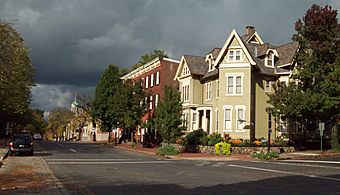Central Bethlehem Historic District facts for kids
Quick facts for kids |
|
|
Central Bethlehem Historic District
|
|

West Church Street, Central Bethlehem Historic District, October 2011
|
|
| Location | Bounded by Main, Nevada, and East Broad Streets, and the Lehigh River, Bethlehem, Pennsylvania |
|---|---|
| Area | 132.3 acres (53.5 ha) |
| Architectural style | Late 19th And 20th Century Revivals, Late Victorian, Gothic Revival |
| NRHP reference No. | 72001131, 88000452 (Boundary Increase) |
| Added to NRHP | May 5, 1972; November 7, 1988 (Boundary Increase) |
The Central Bethlehem Historic District is a special area in Bethlehem, Pennsylvania. It's like a time capsule! This district is recognized as a national historic place. It helps us remember and protect important buildings and sites from the past. It was first added to the National Register of Historic Places in 1972. Later, in 1988, the protected area was made a bit bigger.
Contents
Discovering the Central Bethlehem Historic District
This historic district is found in both Lehigh County and Northampton County, Pennsylvania. It covers about 132 acres. Imagine a large outdoor museum! This area includes many old buildings and important places.
What You'll Find in the District
The Central Bethlehem Historic District is home to many interesting things. It has 165 buildings that help tell its story. There are also 6 special sites, like the Nisky Hill Cemetery. You can also find 9 structures and 4 objects that are part of its history.
Most of the buildings here are homes. But you will also see shops and businesses along Main Street. These buildings were mostly built between the mid-1700s and the early 1900s. Many are about two and a half stories tall. They are often made of strong materials like brick or stone. Some newer homes are made of wood.
Bethlehem's Journey: From Moravian Village to Industrial Hub
The district shows how Bethlehem grew over time. It started as a unique Moravian community. This was from 1741 to 1844. The Moravians were a religious group. They built their community with a special plan.
Later, from 1845 to 1938, Bethlehem became an important industrial town. This meant it had many factories and businesses. The buildings in the district show these big changes. They tell the story of how the town developed.
Important Places to See
There are several notable buildings in the district. Some of these are old Moravian communal buildings. These were places where the community lived and worked together. The George H. Myers Building is another important structure. You can also see the famous Hill to Hill Bridge. This bridge connects different parts of Bethlehem.
The Lehigh Canal is also located within the district. It is so important that it is listed separately as a historic place. Canals like this were once vital for transporting goods.



